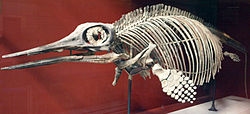| Ophthalmosaurids Temporal range: Middle Jurassic-Late Cretaceous, 174.1–93.9 Ma PreꞒ Ꞓ O S D C P T J K Pg N | |
|---|---|

| |
| Composite skeleton (NHMUK PV R3702, R3893, R4124) of Ophthalmosaurus icenicus at the Natural History Museum, London | |
| Scientific classification | |
| Domain: | Eukaryota |
| Kingdom: | Animalia |
| Phylum: | Chordata |
| Class: | Reptilia |
| Order: | †Ichthyosauria |
| Clade: | †Baracromia |
| Family: | †Ophthalmosauridae Baur, 1887 |
| Subgroups | |
| |
| Synonyms | |
| |
Ophthalmosauridae is an extinct family of thunnosaur ichthyosaurs from the Middle Jurassic to the early Late Cretaceous (Bajocian - Cenomanian) worldwide. Almost all ichthyosaurs from the Middle Jurassic onwards belong to the family, until the extinction of ichthyosaurs in the early Late Cretaceous. Ophthalmosaurids appeared worldwide during early Bajocian, subsequent to the disappearance of most other ichthyosaur lineages after the end of the Toarcian. Currently, the oldest known ophthalmosaurids is Mollesaurus from the early Bajocian of Argentina, as well as indeterminate remains of the same age from Luxembourg and Canada. Named by George H. Baur, in 1887, the family contains the basal taxa like Ophthalmosaurus. Appleby (1956) named the taxon Ophthalmosauria which was followed by some authors, but these two names are often treated as synonyms; Ophthalmosauridae has the priority over Ophthalmosauria. However, some researchers argue that Ophthalmosauridae should be restricted to the group typically referred to as Ophthalmosaurinae, with classic Platypterygiinae instead being referred to as Undorosauridae or Brachypterygiidae and Ophthalmosauria being used to unite these two groups.
Phylogeny

Ophthalmosauridae is a node-based taxon defined by Ryosuke Motani (1999) as "the last common ancestor of Brachypterygius extremus and Ophthalmosaurus icenicus and all of its descendants". The definition he proposed for Ophthalmosauria was exactly the same. In this case both definitions are synonyms. The cladogram below follows the topology from a 2010 analysis by Patrick S. Druckenmiller and Erin E. Maxwell.
| Thunnosauria |
| ||||||||||||||||||||||||||||||||||||||||||||||||||||||||||||||||||||||||
Valentin Fischer, Edwige Masure, Maxim S. Arkhangelsky and Pascal Godefroit (2011) described a new genus of Ophthalmosauridae. They redefined it as "the last common ancestor of Arthropterygius chrisorum and Ophthalmosaurus icenicus and all of its descendants". In this case Ophthalmosauria isn't a junior synonym of Ophthalmosauridae. The cladogram below follows Fischer et al. 2011.
| Thunnosauria |
| |||||||||||||||||||||||||||||||||||||||||||||||||||||||||||||||||||||||||||
*Note: Placement of Ophthalmosauria by definition.
Fischer et al. (2012) described another new genus of Ophthalmosauridae. They defined for the first time two subfamilies within the Ophthalmosauridae, Ophthalmosaurinae and Platypterygiinae. Ophthalmosaurus and Platypterygius were found to be non-monophyletic. Ophthalmosauridae was characterized by a reduced extracondylar area, a plate-like dorsal trochanter, a humerus with a facet for an anterior accessory element and the absence of notching on the paddle elements of the forefin. The cladogram below follows Fischer et al. 2012.
| Thunnosauria |
| ||||||||||||||||||||||||||||||||||||||||||||||||||||||||||||||||||||||||||||||||||||||||||
Since 2019
In 2019, two species of Cryopterygius were assigned to the genus Undorosaurus by Zverkov & Efimov (2019). The authors considered the type species of the former genus, C. kristiansenae, to be synonymous with Undorosaurus gorodischensis; second species of Cryopterygius, C. kielanae, was tentatively maintained by the authors as a distinct species within the genus Undorosaurus.
The following cladogram shows a possible phylogenetic positions within Ophthalmosauridae according to the analysis performed by Zverkov and Jacobs (2020).
| Ophthalmosauria |
| ||||||||||||||||||||||||||||||||||||||||||||||||||||||||||||||||||||||||||||||||||||||||||||||||||||||||||||||||||||||||||||||||||||||||||||||||||||||||||||||||||||||||||||||||||||||||||||||||||||||||||||||||||||||||
References
- ^ Fischer, V.; Masure, E.; Arkhangelsky, M.S.; Godefroit, P. (2011). "A new Barremian (Early Cretaceous) ichthyosaur from western Russia". Journal of Vertebrate Paleontology. 31 (5): 1010–1025. Bibcode:2011JVPal..31.1010F. doi:10.1080/02724634.2011.595464. hdl:2268/92828. S2CID 86036325.
- ^ Fischer, Valentin; Weis, Robert; Thuy, Ben (2021-02-22). "Refining the marine reptile turnover at the Early–Middle Jurassic transition". PeerJ. 9: e10647. doi:10.7717/peerj.10647. ISSN 2167-8359. PMC 7906043. PMID 33665003.
- Marta S. Fernández (1999). "A new ichthyosaur from the Los Molles Formation (Early Bajocian), Neuquen Basin, Argentina". Journal of Paleontology. 73 (4): 677–681. Bibcode:1999JPal...73..677F. doi:10.1017/S0022336000032492. JSTOR 1306766. S2CID 130751356.
- ^ Ryosuke Motani (1999). "Phylogeny of the Ichthyopterygia" (PDF). Journal of Vertebrate Paleontology. 19 (3): 472–495. Bibcode:1999JVPal..19..473M. doi:10.1080/02724634.1999.10011160. Archived from the original (PDF) on 2016-03-05. Retrieved 2011-10-19.
- ^ Patrick S. Druckenmiller; Erin E. Maxwell (2010). "A new Lower Cretaceous (lower Albian) ichthyosaur genus from the Clearwater Formation, Alberta, Canada". Canadian Journal of Earth Sciences. 47 (8): 1037–1053. Bibcode:2010CaJES..47.1037D. doi:10.1139/E10-028.
- Zverkov, N. G.; Efimov, V. M. (2019). "Revision of Undorosaurus, a mysterious Late Jurassic ichthyosaur of the Boreal Realm". Journal of Systematic Palaeontology. 17 (14): 963–993. Bibcode:2019JSPal..17.1183Z. doi:10.1080/14772019.2018.1515793. S2CID 91912834.
- Cortés, D; Maxwell, E. E.; Larsson, H. C. E. (2021). "Re-appearance of hypercarnivore ichthyosaurs in the Cretaceous with differentiated dentition: Revision of "Platypterygius" sachicarum (Reptilia: Ichthyosauria, Ophthalmosauridae) from Colombia". Journal of Systematic Palaeontology. 19 (14): 969–1002. Bibcode:2021JSPal..19..969C. doi:10.1080/14772019.2021.1989507. S2CID 244512087.
- ^ Arkhangel'sky, M. S., 1998, On the Ichthyosaurian Genus Platypterygius: Palaeontological Journal, v. 32, n. 6, p. 611-615.
- Valentin Fischer; Michael W. Maisch; Darren Naish; Ralf Kosma; Jeff Liston; Ulrich Joger; Fritz J. Krüger; Judith Pardo Pérez; Jessica Tainsh; Robert M. Appleby (2012). "New Ophthalmosaurid Ichthyosaurs from the European Lower Cretaceous Demonstrate Extensive Ichthyosaur Survival across the Jurassic–Cretaceous Boundary". PLOS ONE. 7 (1): e29234. Bibcode:2012PLoSO...729234F. doi:10.1371/journal.pone.0029234. PMC 3250416. PMID 22235274.
- Nikolay G. Zverkov & Vladimir M. Efimov (2019). "Revision of Undorosaurus, a mysterious Late Jurassic ichthyosaur of the Boreal Realm". Journal of Systematic Palaeontology. 17 (14): 963–993. Bibcode:2019JSPal..17.1183Z. doi:10.1080/14772019.2018.1515793. S2CID 91912834.
- Nikolay G. Zverkov & Megan L. Jacobs (2021) . "Revision of Nannopterygius (Ichthyosauria: Ophthalmosauridae): reappraisal of the 'inaccessible' holotype resolves a taxonomic tangle and reveals an obscure ophthalmosaurid lineage with a wide distribution". Zoological Journal of the Linnean Society. 191 (1): 228–275. doi:10.1093/zoolinnean/zlaa028.
| Taxon identifiers | |
|---|---|
| Ophthalmosauridae |
|







